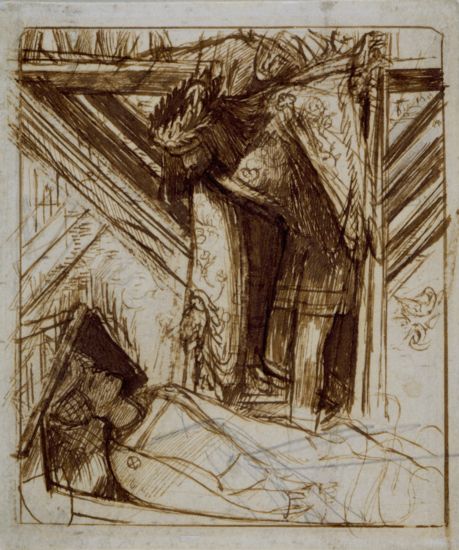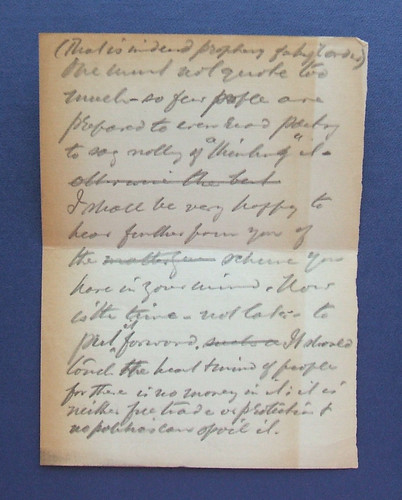The Man Behind "The Lady"
Portia Favro and Marilee Devries
1302
|
When one pictures the Victorian Era, one may immediately visualize men in black coats and perhaps women in full dresses with lace collars based on visual images they have seen. However, poetry created during this time period (roughly the middle of the 19th century), depicts a different kind of world through illustration in various contexts. Alfred Lord Tennyson, a popular poet during the Victorian Era, wrote the poem “The Lady of Shalott” in 1832, which can be seen as a comment on the social practice and role of women within the society. Artists throughout the period and later in the century accompanied the poem with a plethora of interpretations of "the Lady" and the story of the poem, which comments on how men within the middle class got to make decisions, rules and conclusions about where women are placed, and how they should be seen to act, within society. |
After a first read, one often considers Alfred Lord Tennyson’s “The Lady of Shalott” to be a beautiful, albeit tragic, love story. However, when read with a critical perspective and in context with the Victorian era (during which it was written) and the place Tennyson held in society at the time of publication, an entirely different connotation of the poem can be discovered.
Tennyson was twenty-three years old when he wrote “The Lady of Shalott” in 1832. At this point he was a new name to world of poetry, having published only one book of poems two years earlier.@Perry, Seamus. Alfred Tennyson. Tavistock, UK: Northcote House Publishers, Ltd, 2005. Print. 8. It would be many years before his success and popularity would lead to him being appointed Poet Laureate.@Perry, Seamus. Alfred Tennyson.Tavistock, UK: Northcote House Publishers, Ltd, 2005. Print. 7. He held a societal role as a middle-class man, and was newly educated at Cambridge - although he was required to drop out before completing his degree due to the death of his father.@Perry, Seamus. Alfred Tennyson. Tavistock, UK: Northcote House Publishers, Ltd, 2005. Print. 5. As far as records show, romance was scarce to non-existent at this point in Tennyson’s life, which makes one wonder where the apparent romantic tone of “The Lady of Shalott”, complete with ‘bold Sir Lancelot’ originates.
However, the tone of the poem, and the overall message, can be interpreted as something other than romantic; interpreted to stand as a comment on certain facets of society, made by the poet himself. In this exhibit, we will examine comments made on the role of women during the Victorian era that we argue can be found in “The Lady of Shalott.”
Tennyson was twenty-three years old when he wrote “The Lady of Shalott” in 1832. At this point he was a new name to world of poetry, having published only one book of poems two years earlier.@Perry, Seamus. Alfred Tennyson. Tavistock, UK: Northcote House Publishers, Ltd, 2005. Print. 8. It would be many years before his success and popularity would lead to him being appointed Poet Laureate.@Perry, Seamus. Alfred Tennyson.Tavistock, UK: Northcote House Publishers, Ltd, 2005. Print. 7. He held a societal role as a middle-class man, and was newly educated at Cambridge - although he was required to drop out before completing his degree due to the death of his father.@Perry, Seamus. Alfred Tennyson. Tavistock, UK: Northcote House Publishers, Ltd, 2005. Print. 5. As far as records show, romance was scarce to non-existent at this point in Tennyson’s life, which makes one wonder where the apparent romantic tone of “The Lady of Shalott”, complete with ‘bold Sir Lancelot’ originates.
However, the tone of the poem, and the overall message, can be interpreted as something other than romantic; interpreted to stand as a comment on certain facets of society, made by the poet himself. In this exhibit, we will examine comments made on the role of women during the Victorian era that we argue can be found in “The Lady of Shalott.”
|
In January 1832, the year the poem was published, a letter@Hallam, Arthur Henry. Letter. Trinity College, England, 1832. Web. was sent from Arthur Hallam, Tennyson’s best friend, to Emily Tennyson, the poet’s sister.The letter, sent from Hallam’s location at Trinity College, was in regard to Tennyson’s delicate health. Tennyson, who was prone to bouts of paranoia in fear of developing a mental disorder (due to a family history staggered with several cases of the malady@Everett, Glenn. Alfred Tennyson: A Brief Biography. Tennessee: University of Tennessee at Martin, 2004. Print. 8.), appeared to be suffering from a type of depression. In the letter, Hallam wrote ‘the more morbidly intense our inward contemplation of ourselves is, the more hollow and delusive we consider any temporary and apparently irrelevant diversion.'@Hallam, Arthur Henry. Letter. Trinity College, England, 1832. Web. This suggests the dark times Tennyson was experiencing and the difficulties his family was having in rousing him.
This information holds a particular significance to the meanings that can be read within "The Lady of Shalott", which Tennyson penned within the same year as his spell of disheartenment. As Herbert Tucker writes, '“The Lady of Shalott” clearly narrates the world’s failure to requite the desires of the self”@Tucker, Herbert F. Tennyson and Doom of Romanticism. Cambridge, Massachusetts: Harvard University Press, 1988. Print.100.. An argument can in fact be made, within the context of Hallam’s letter, that Tennyson felt that the world in which he lived, the dominate culture, did not provide the fulfillment one needed to be happy. Tennyson used these feelings to make comments on society, which he in turn shares through his poem, “The Lady of Shalott.” The female gender of "the Lady," and the limitations and tragedy she encounters in the poem, lend to Tennyson’s apparent critique on the cultural role that women were expected to hold in the Victorian era. |

A letter found among Tennyson's things.
|


